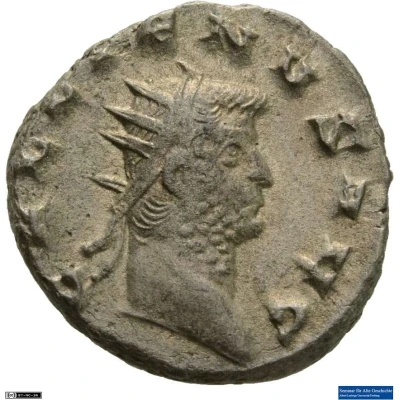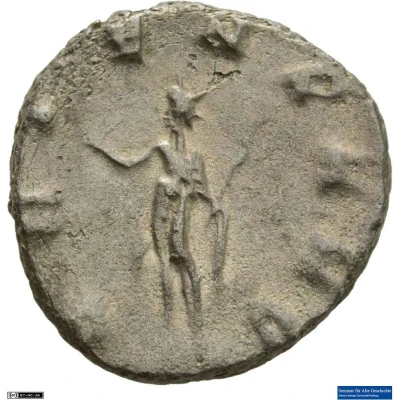


© Münzsammlung des Seminars für Alte Geschichte, Albert-Ludwigs-Universität Freiburg (CC BY-NC-SA 3.0 DE)
Antoninianus - Gallienus ORIENS AVG; Sol
| Silver | 3.9 g | 19 mm |
| Issuer | Rome › Roman Empire (27 BC - 395 AD) |
|---|---|
| Emperor | Gallienus (Publius Licinius Egnatius Gallienus) (253-268) |
| Type | Standard circulation coin |
| Years | 260-268 |
| Value | Antoninianus (1) |
| Currency | Antoninianus, Reform of Caracalla (AD 215 – 301) |
| Composition | Silver |
| Weight | 3.9 g |
| Diameter | 19 mm |
| Shape | Round (irregular) |
| Technique | Hammered |
| Demonetized | Yes |
| Updated | 2024-10-05 |
| Numista | N#289152 |
|---|---|
| Rarity index | 100% |
Reverse
Sol, radiate, nude except for cloak on shoulders, standing left, raising right hand and holding whip in left hand.
Script: Latin
Lettering: ORIENS AVG
Translation:
Oriens Augusti.
The rising sun of the emperor (Augustus).
Comment
Mass varies: 3.22–4.53 g;Diameter varies: 18–20 mm;
Example of this type:
Münzsammlung des Seminars für Alte Geschichte, Albert-Ludwigs-Universität Freiburg
Source:
Online Coins of the Roman Empire (OCRE)
Interesting fact
The Antoninianus coin was issued during the reign of Gallienus, who was the Roman Emperor from 260 to 268 AD. During his reign, the Roman Empire was facing numerous challenges, including invasions by barbarian tribes and internal conflicts. Despite these challenges, Gallienus was able to maintain the empire's stability and issue coins like the Antoninianus, which were used for trade and commerce. The coin's design features the image of Sol, the Roman god of the sun, on the obverse (front side), and the emperor's name and title on the reverse (back side). The use of Sol's image on the coin was a common practice during the Roman Empire, as the sun was considered a symbol of power and divinity. Overall, the Antoninianus coin is an interesting piece of history that provides insight into the Roman Empire's economy, politics, and religious beliefs during the 3rd century AD.